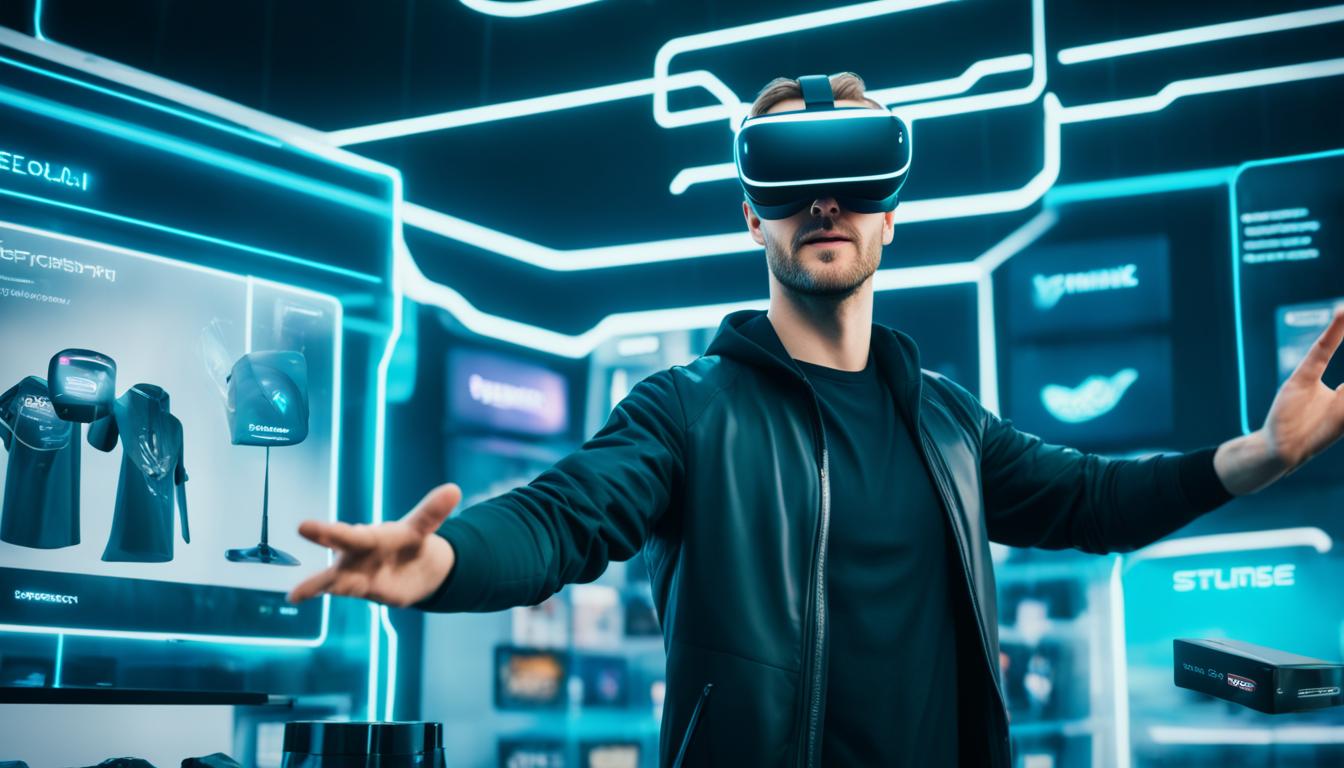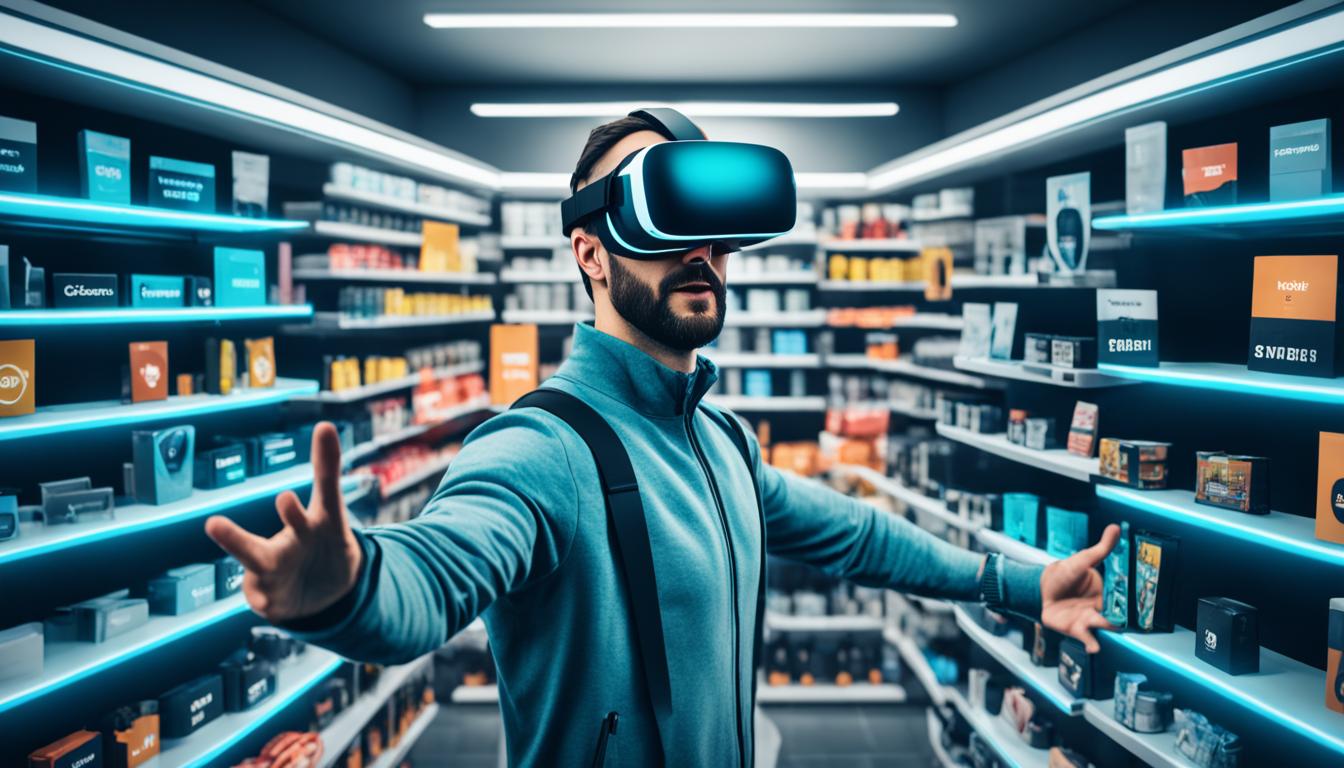
The retail landscape is on the brink of a transformative shift, as virtual shopping experiences are poised to revolutionize the way we shop. By 2025, the Metaverse, accessed through augmented reality (AR) and virtual reality (VR), is becoming the new mall, offering customers dynamic and stimulating shopping experiences. Compelling statistics reveal that an astonishing 70% of visitors to virtual stores ultimately made a purchase, underscoring the effectiveness of such immersive digital experiences.
As the digital landscape continues to evolve, retailers must innovate to deliver quality products, services, and experiences that cater to the changing demands of consumers. Virtual shopping will seamlessly blend online and in-store environments, providing you with a seamless and engaging shopping journey that blurs the lines between the physical and digital realms.
Key Takeaways:
- Virtual shopping will revolutionize the retail industry by 2025, offering immersive digital experiences.
- The Metaverse, accessible through AR and VR, is becoming the new shopping mall for consumers.
- Compelling statistics show that 70% of visitors to virtual stores ultimately make a purchase.
- Retailers must innovate to deliver quality products, services, and experiences that cater to evolving customer demands.
- Virtual shopping will seamlessly blend online and in-store environments, providing a seamless and engaging shopping journey.
The Rise of Immersive Virtual Shopping
Immersive virtual shopping experiences are transforming the retail landscape, offering customers a captivating digital alternative to the traditional in-store journey. These innovative platforms transport shoppers into virtual storefronts, enabling them to browse, interact, and engage with products in ways that defy the limitations of the physical world.
What is Immersive Virtual Shopping
Immersive virtual shopping mirrors the experience of stepping into a physical store, transporting customers into a virtual shop from the comfort of their homes. The virtual shop is intended to emulate an in-person experience where users can browse, pick up, try on, and interact with different objects. Some shops have even introduced special effects that are only possible in the virtual environment and defy real-world limitations, such as gravity manipulation, material and spatial distortion, and other interactive personalized activations that enhance the immersive experience.
Impact on Consumer
Immersive virtual shopping has the potential to democratize luxury, making it accessible to a wider audience. By breaking down geographical barriers and eliminating the need for physical store visits, immersive virtual shopping platforms provide an opportunity for individuals across the globe, regardless of socioeconomic status, to explore and experience products and services. This level of accessibility also allows individuals who may not have had the opportunity to physically visit luxury stores to appreciate the craftsmanship, design, and quality associated with luxury brands, breaking typical traditional fashion barriers. Additionally, the fashion industry has begun blending its campaigns with gamification strategies as a way to playfully target a younger audience, captivating fashion enthusiasts and devoted gamers alike through minigames, quests, and contests that offer exclusive rewards.
Impact on Brands
Brands that move into virtual shopping are generating buzz while championing digital innovation, and as early adopters, they can expect a surge in brand visibility and loyalty. Incorporating personalization and storytelling into online retail can greatly enhance brand loyalty and overall performance. In today’s digital landscape, users have higher expectations for their online shopping experiences, seeking a more engaging journey that aligns with the brand’s values and caters to their unique needs, desires, and preferences. Through these strategies, companies can strategically collect extremely valuable data that will further optimize operations, enhance a brand’s image, and set it apart from competitors.
Virtual Shopping Platforms and Campaigns
Companies such as Obsess and Emperia are leading global platforms that use 3D technologies to make shoppable storefronts and experiences in
virtual reality (VR)
possible. Collectively, Obsess and Emperia have built more than 250 virtual stores for major global retailers, designers, and museums, spearheading the VR commerce economy. By leveraging the services offered by these platforms, VR emerges as a powerful tool for crafting immersive environments and compelling narratives, allowing brands to engage with their digitally savvy audience in interactive ways. These platforms offer capabilities that can effectively educate customers about the value of the product and provide tools that extend beyond real-time interactions, allowing brands to integrate the virtual storefront with existing e-commerce stock management software to track demographics, store activities, and purchases.
Crocs
In July 2023, quirky footwear giant Crocs forged a partnership with Obsess, opening its virtual store. The highly interactive “Crocs Jibbitz Experience” involves a Jibbitz claw game that rewards players with special discounts and a platform to customize your own clog with an assortment of Jibbitz. After customizing, players directly shop the shoe along with the Jibbitz. This riveting journey reimagines Crocs’ customization journey and resonates with its youthful audience while staying aligned with its fun and playful branding.
Lacoste
In the same month, Emperia developed a truly remarkable virtual store for Lacoste, seamlessly fusing alluring visuals and bright colors with the featured clothing line, shoes, and accessories. The store was available solely to members of Le Club Lacoste and UNDW3, the brand’s loyalty program and Web3 community. As part of this thrilling campaign, in-person shoppers were invited to activate the experience by simply scanning the QR code attached to each physical item of the collection in-store, granting them access to a digital twin of the product to be redeemed using
augmented reality (AR)
technology. The virtual experience was immaculately executed, and Lacoste’s focus on its loyal fans sparked excitement in the fashion and Web3 communities, setting the stage for a new era of retail.
Gucci
During Milan Fashion Week in September 2023, in partnership with Roblox, Gucci launched the rebranded Gucci Town, coined “Gucci Ancora”. Gucci Ancora served as a platform where both participants from the live event and those who were unable to attend the in-person show could still engage virtually and participate in immersive games to win prizes and unlock various elements. By playing minigames and completing various tasks and quests online, participants can collect up to 16 exquisite virtual fashion items from Gucci’s 2024 Spring Collection. Gucci Ancora offered a dynamic and inclusive experience that allowed fashion week attendees to go beyond passive observation and actively indulge in the fashion experience and learn about Gucci’s heritage.

Challenges and Considerations for Virtual Shopping
As the adoption of virtual shopping experiences continues to grow, both brands and consumers face unique challenges that must be addressed. These considerations are crucial in ensuring the seamless integration of
virtual reality shopping
,
augmented reality retail
, and
immersive e-commerce
into the evolving retail landscape.
Accessibility and Hardware Requirements
When it comes to accessing the Web3 experience, it can come at a relatively high cost for both brands and consumers. For in-store activations, brands may need to invest in hardware such as VR headsets or goggles, while those at home will need to own a pair of compatible gear themselves to fully participate in the virtual shopping experiences. Such barriers can severely limit the reach brands have while operating a virtual experience – therefore, companies need to strike a balance between the quality of immersion and accessibility.
Addressing Privacy and Security Concerns
Virtual shop technologies are advancing, but in their current state, a few privacy and security concerns still persist. Shopping platforms handle sensitive customer data, including personal information and payment details, and are not entirely immune to potential data leaks that may severely harm the brand and its shoppers.
Limited Capabilities
Although virtual shops offer a higher level of interactivity compared to the Web2 experiences we are used to, they still fall short of fully replicating the in-store experience found in the physical world. One prominent limitation is the lack of a tactile “touch and feel” aspect for customers. Hence, when considering appropriate immersive e-commerce strategies, it’s essential to acknowledge that VR and AR technologies may not be suitable for every product category. Virtual shops must effectively showcase products in a visually captivating and informative manner. In the virtual realm, it is important for brands to ensure accurate representations, high-quality images, and detailed product information to compensate for the inability to physically touch and examine items.
Conclusion
As the retail landscape continues to evolve, virtual shopping experiences will play an increasingly significant role in shaping the future of the industry. By blending immersive technologies like virtual reality shopping and augmented reality retail with e-commerce, retailers can offer customers a more engaging, personalized, and accessible shopping journey. Platforms like Obsess and Emperia are leading the charge in creating immersive e-commerce experiences, allowing brands to captivate their digitally savvy audience through online avatar shopping and digital product visualization.
While virtual shopping presents both opportunities and challenges, such as accessibility and hardware requirements, addressing privacy and security concerns, and limited capabilities, forward-thinking brands that embrace this innovative approach will be well-positioned to captivate a new generation of consumers and drive the future of retail experiences. By seamlessly integrating the physical and digital realms, you can provide your customers with a truly unique and memorable shopping journey that sets your brand apart in the increasingly competitive landscape.
As the retail industry continues to evolve, it’s clear that virtual shopping will play a pivotal role in shaping the future of the customer experience. By staying ahead of the curve and embracing these emerging technologies, you can position your brand as a leader in the industry and deliver a level of engagement and personalization that your customers have come to expect. The future of retail is here, and those who are willing to embrace the rise of virtual shopping will be the ones to shape it.
FAQ
What is immersive virtual shopping?
Immersive virtual shopping mirrors the experience of stepping into a physical store, transporting customers into a virtual shop from the comfort of their homes. The virtual shop is intended to emulate an in-person experience where users can browse, pick up, try on, and interact with different objects.
How does immersive virtual shopping impact consumers?
Immersive virtual shopping has the potential to democratize luxury, making it accessible to a wider audience. By breaking down geographical barriers and eliminating the need for physical store visits, immersive virtual shopping platforms provide an opportunity for individuals across the globe, regardless of socioeconomic status, to explore and experience products and services.
How do brands benefit from virtual shopping experiences?
Brands that move into virtual shopping are generating buzz while championing digital innovation, and as early adopters, they can expect a surge in brand visibility and loyalty. Incorporating personalization and storytelling into online retail can greatly enhance brand loyalty and overall performance.
What virtual shopping platforms and campaigns have been successful?
Companies such as Obsess and Emperia are leading global platforms that use 3D technologies to make shoppable storefronts and experiences in VR possible. Crocs partnered with Obsess to open a virtual “Crocs Jibbitz Experience”, Lacoste developed a virtual store with Emperia, and Gucci launched the “Gucci Ancora” on Roblox during Milan Fashion Week.
What are the challenges and considerations for virtual shopping?
Accessing the Web3 experience can come at a relatively high cost for both brands and consumers. Virtual shop technologies also present privacy and security concerns, and they still fall short of fully replicating the in-store experience found in the physical world, particularly the lack of a tactile “touch and feel” aspect for customers.
